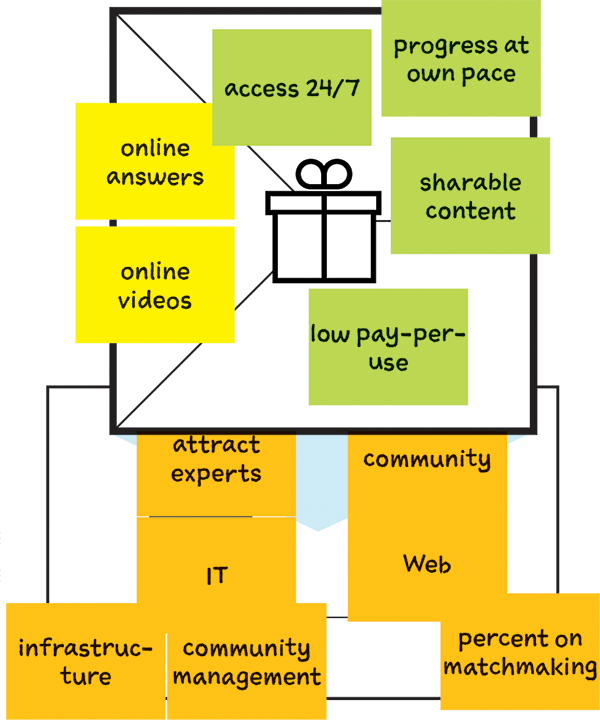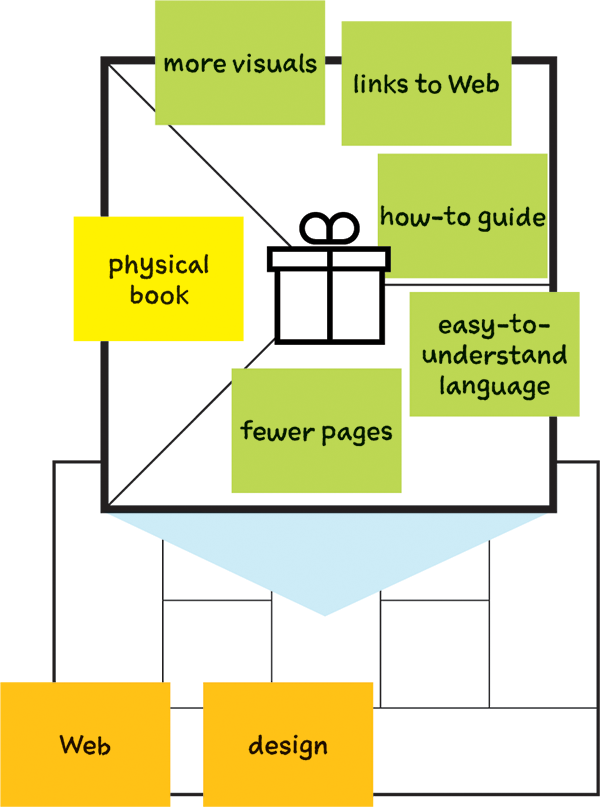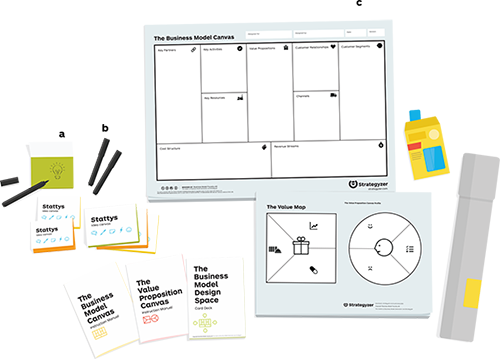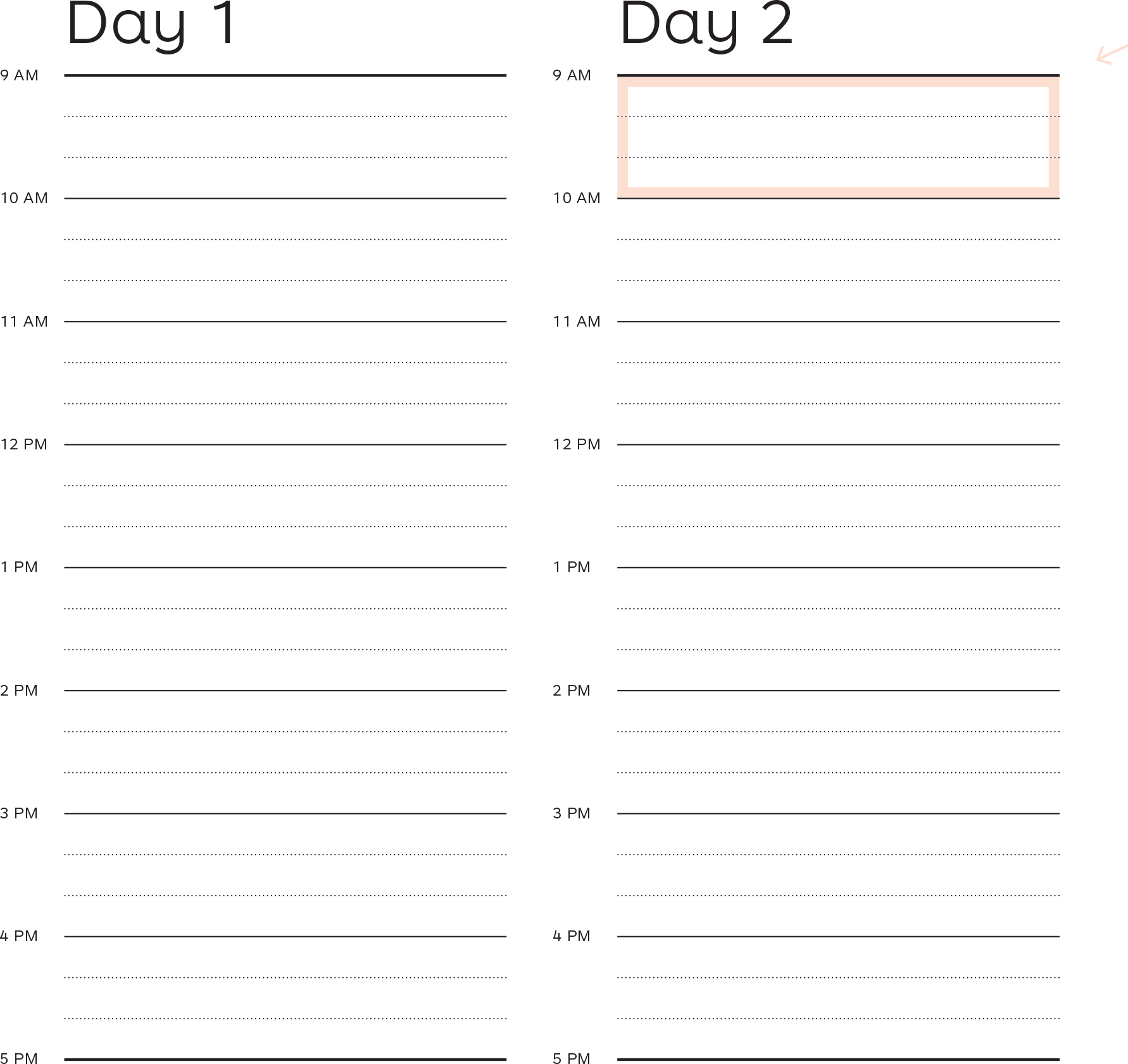2.6
Designing in Established Organizations

Adopt the Right Attitude to Invent or Improve
Existing organizations need to improve existing value propositions and create new ones proactively. Make sure you understand on which end of the spectrum you are at the beginning of a particular project, because each requires a different attitude and process. Great companies will have a balanced portfolio of projects covering the entire spectrum from improve to invent.
The Business Book of the Future
Imagine if you were a business book publisher. How could you improve your present offering and invent the business book of the future, which might not even be a book anymore? We sketched out three ideas along the invent-improve spectrum.

The YouTube of business education
An online platform matching videos from business experts with customers who are looking for answers to their problems. This would require a substantial extension or reinvention of the business model of publishing books.

This concept requires an entirely different business model and makes the original one obsolete.
The 1-800-Business-Book hotline
A hotline number extending physical business books and offering on-demand answers. This would build on the existing business model but require an extension from a sales to a service model.

Improvements add to the value proposition and require only minor tweaks to the business model.
The practical business book
Improve business books by making them more visual and applicable without altering the core business model behind it substantially.

An additional service capability adds a layer to the business model but doesn’t transform it.
The more you move toward the invent end of the spectrum, the more your new value proposition will differ from your existing ones. Inventing new value propositions provides an opportunity to more closely address jobs that really matter to customers (in this case, getting answers to business questions).
Our three-tier value proposition consists of a physical book, sharable practical content online, and advanced learning through our online course. It is our attempt to push the boundaries of business learning and doing.
The value proposition of this book combined with online exercises and material on Strategyzer.com is our attempt to more closely address the jobs we believe matter to our readers.
![]()
Reinvent by Shifting from Products to Services
Construction equipment manufacturer Hilti reinvented its value proposition and business model by shifting from products to services. Its move from selling branded machine tools to guaranteeing timely access to them required a substantial overhaul not just of their value proposition but also of their business model. Let’s learn how Hilti did it.
Many organizations aspire to regain a competitive advantage by transforming from a product manufacturer into a service provider. This requires a substantial reinvention.
An Expired Model
Hilti’s old model focused mainly on selling high- quality machine tools directly to builders. They were known for breaking less often, lasting longer, and overall being less costly by minimizing time loss. Hilti tools also have a reputation for being particularly safe and enjoyable to work with.
Unfortunately, this old model was one of decreasing margins and subject to competition from lower-cost competitors.

Hilti focused on a new job to be done after discovering that its tools were related to a more important customer job: that of delivering projects on time to avoid financial penalties. They learned that broken, malfunctioning, or stolen tools could lead to major delays and penalties. From there, Hilti moved toward a new value proposition, offering services around machine tools.
A Fresh Start
Hilti used its new service-based value proposition to create more value for construction companies by ensuring that they had the right tools at the right place at the right time. This would help construction companies achieve a much more predictable cost management and keep operations profitable.
Impact on the Business Model
Moving from products to services sounds like an easy and obvious value proposition shift, but it requires substantially reengineering the business model. Hilti had to add substantial new service resources and activities in addition to manufacturing. But it was worth it. With their new value proposition, Hilti achieves higher margins, recurring revenues, and better differentiation.

New service created: monthly subscriptions to fleet management utility; “New” customer, more important job identified: delivering on time!
![]()
The Perfect Workshop Setting
Workshops are an important part of value proposition design in established organizations. Great workshops can make a big difference in the design process and lead to better results. The questions below will help you create the perfect setting.
Who should join?
Invite people with different backgrounds, especially when you know there will be a substantial effect on the business model. Their buy-in is crucial. Get customer-facing staff to participate to leverage their knowledge. Customers or partners may also be a good addition to help evaluate value propositions.
What should the format be?
As a rule of thumb, more viewpoints are generally better than fewer at the early stages of value proposition design. With 10 participants or more, you can explore several alternatives in parallel by working in groups of five. Smaller teams need to explore alternatives sequentially. At the later stages of developing and refining value propositions, fewer participants are usually better.
How can space be used as an instrument?
Great workshop spaces are an often-overlooked instrument to create outstanding workshops with exceptional outcomes. Choose a space that is sufficiently large and offers large walls or working areas. Set up the space to support creation, collaboration, and productivity. For breakthrough results, choose an unusual and inspiring venue.
What tools and materials are needed?
Prepare a self-service area with canvas posters, sticky notes, paper, blue tack, markers, and other tools so participants can help themselves with what they need.

a. Use sticky notes to move ideas around—ideally in several colors for color-coding.
b. Use thick markers so ideas are visible from afar.
c. Use wall-sized posters to sketch out big ideas.
 Check readily available workshop material
Check readily available workshop material

a. Small Group Areas | This is where work gets done. Four or five people per group is best. Do not use chairs or tables unless required for specific work. Keep working groups in the same room rather than a break-out room to retain high energy levels throughout the workshop. |
b. Work-in-Progress Gallery/Inspiration Wall | Set up an area where you can expose canvases and other work in progress. Add an “inspiration wall” with content that participants can draw from, such as reference models, examples, and models of competitors. |
c. Projector and Screen | This is used to show slides or customer videos. It should be easily viewable by all. |
d. Room Control | This space should be set aside for the facilitator and team to access computer, sound system, Wi-Fi, and maybe a printer. |
e. Plenary Space | Everyone can meet here for plenary presentations and discussions. It can be set up with or without tables. |
f. Venue Size, Look, and Feel | As a rule of thumb, calculate 50m2 per 10 participants. Favor inspiring venues over boring hotel meeting rooms. |
g. Walls | Large vertical surfaces are indispensable, whether movable or part of the building. Make sure you can stick large posters, sticky notes, and flip chart paper on them. |
![]()
Compose Your Workshop
A great workshop produces tangible and actionable outcomes. Use the tools and processes from this book to start designing a draft workshop outline that leads to great results.

Use the modules below as a menu of options to draft a workshop agenda.
Before Your Workshop
Do your homework and gather customer insights
After Your Workshop
Get going with testing your value propositions and business models in the real world
Prototype Possibilities |
Making Choices |
|
|
|
|
|
Back and Forth with Business Model |
|
|
|
|
|
|
|
Preparing Tests |
|
|
|
|
|
|
|
|
|
|
|
|
|
|
|
|
|
|
|
Breaks |
|
Lunch |
|
|
|
|
|
Coffee and snacks |
![]()
